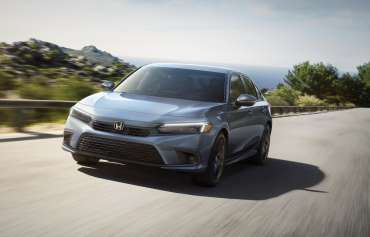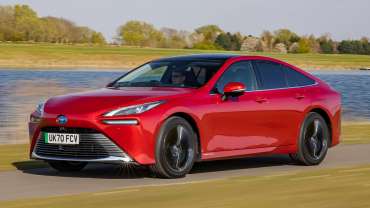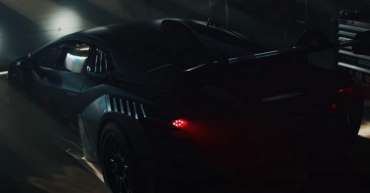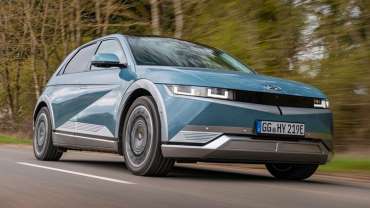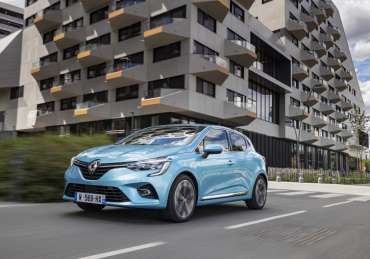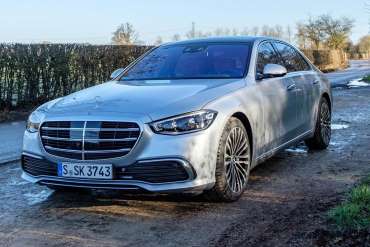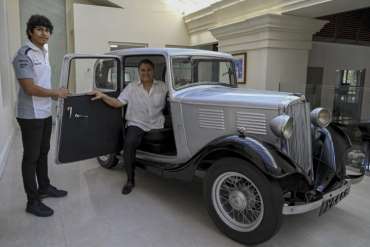
Worldcarblog.com
New and unusual Honda Civic finally discovered (PHOTO)
Finally, all the details of the 11th generation Honda Civic Sedan are known, which brings a lot of state-of-the-art technology and unusual design. He is unusual because he is no longer overly aggressive. The new Civic will strive to remain one of the best-selling cars in the United States for the last 50 years.
After a short announcement from Honda in April, which was accompanied by only one photo of the new Civic, the 11th generation of this model was finally presented in a four-door sedan version.
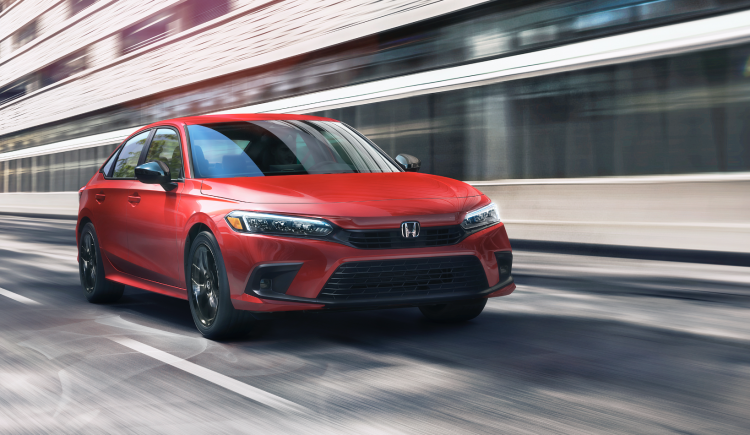
It is technologically refreshed, and the main goal of the company is for the new Civic to continue its success story as one of the best-selling models in the USA, writes Auto Klub.
To achieve this, Honda returned to the original simplicity of design, which was a huge success in the 70's.
And indeed, the new Civic has a bit of design sharp lines but already looks very clean. To simplify the design, Honda has moved the windshield frame back by two centimeters, which makes the bonnet look longer and has classic proportions.
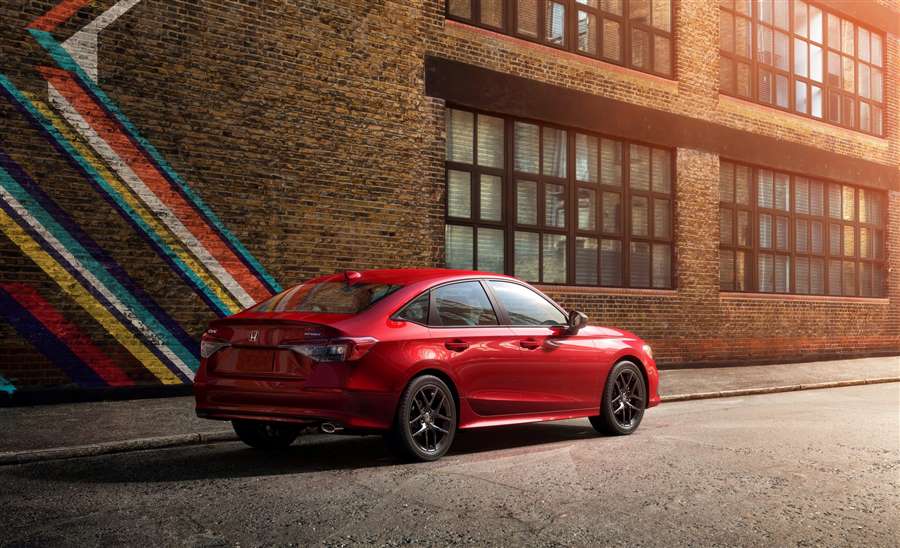
The sharp line that cuts through the body and enters the rear lights of the Civic has been deliberately retained. In addition, the sedan looks much wider due to the stronger "shoulders" at the rear and the wide-set LED lights.
"All this contributes to a car that is not burdened with the weight of unnecessary design tricks," they say in Honda. Three new colors will also be available: Meteorite Gray Metallic, Sonic Gray Pearl and the exclusive Morning Mist Blue Metallic.
In the cabin, the new Civic offers a 10.2-inch digital instrument panel and a 7-inch infotainment system as standard, which is much larger than the dimensions of the outgoing model.
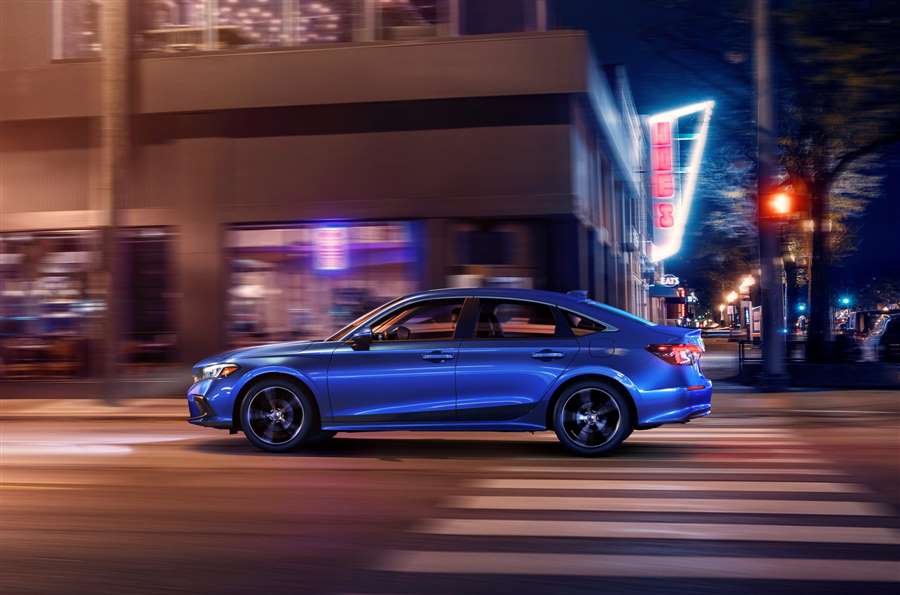
As part of the Man Maximum / Machine Minimum design philosophy, Honda has decided to retain physical controls for certain functions, such as air conditioning and an audio system that can also offer 12 Bose speakers.
When choosing the material in the interior, practicality was taken into account, so that you forget the "piano black" details on which fingerprints remain. Instead, a mesh honeycomb design was used, which looks clean and elegant, and hides ventilation openings that would disrupt the harmony of the front panel.
Moving the windshield provided better visibility outside the car, while longer and wider dimensions contributed to more space for passengers' heads, legs, hips and shoulders, so it can be said that the new Civic is more spacious than ever.

The wheelbase is 3.5 centimeters longer, which contributes to better stability and a smoother ride.
In addition, the strategic use of high-strength steel and aluminum, torsional strength is eight percent better than the older model. And with all that, the weight of the vehicle is reduced.
Today, all new cars have many assistance systems, and the Civic calls its package of active safety technology Honda Sensing, which has been upgraded with a new camera that provides a wider field of view, as well as a system that recognizes pedestrians, cyclists and other vehicles. Cruise control has been improved with more natural braking and faster reaction, as well as a lane keeping system.

We offer two four-cylinder engines - a 2.0-liter atmosphere with 160 hp (118 kW) and 187 Nm of torque, as well as a 1.5-liter turbocharged engine that produces 182 hp (134 kW) and 240 Nm, which is 7 HP more than the same engine in the last generation. In addition, fuel consumption has been reduced.
The new sedan should go on sale this summer, and it will be produced at Honda's factory in Ontario, Canada. A compact version is expected in a few months. However, the prices have not been announced yet, but a little more than 21,250 dollars is expected, which is the price of the current basic model from 2021.
New Toyota Mirai 2021 review
We get behind the wheel of the second-generation Toyota Mirai hydrogen fuel cell car
Verdict
Toyota has learned a great deal about fuel cell cars since the first Mirai was released back in 2014 - and it shows. The new model is improved in pretty much every measurable way, and most subjective ones, too. While limited refuelling options, a cramped interior and a high purchase price mean the Mirai won’t be for everyone, it’s a rolling proof of concept that shows hydrogen will play a big part in a zero-emission future - just maybe not for passenger cars.
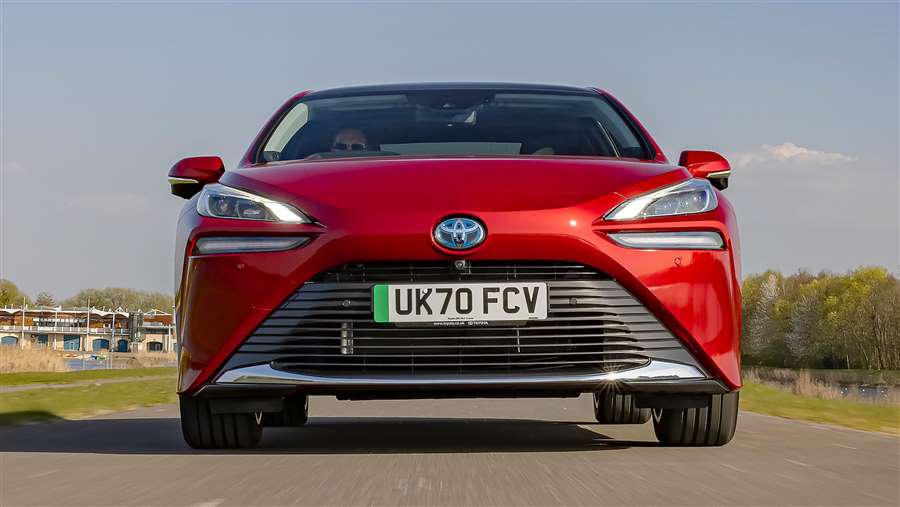
Dare to search out the type of pub monologue given by a person with the confidence only a few drinks can bring, and you’ll hear that the future of motoring isn’t in electric vehicles, but hydrogen.
Here, then, is the all new Toyota Mirai, powered by that very fuel that’s seemingly always been on the cusp of the mainstream. It’s the sleeker, more handsome second-generation model of the brand’s hydrogen fuel cell car, and it proves that the world’s most abundant element can play a huge part in our zero-emission future - just not necessarily for cars.
Hydrogen fuel cells: do hydrogen cars have a future?
Let’s start with how the Mirai works, because this is still, in essence, an EV. A fuel cell works by passing hydrogen across an anode, which splits the atoms into protons and electrons. The electrons then pass through a circuit to generate a flow of electricity, which in turn charges a small lithium-ion battery that, like a regular EV, drives an electric motor.
A clever chemical reaction that sees hydrogen react with oxygen from the atmosphere means the only byproduct is water, as a puff of vapour from the exhaust.
All of this magic happens under the Mirai’s long bonnet. Advancements in the tech since the first-gen car was launched mean that the fuel cell is 50 per cent lighter and physically smaller, yet it makes 12 per cent more power, so the Mirai’s motor now generates 180bhp.
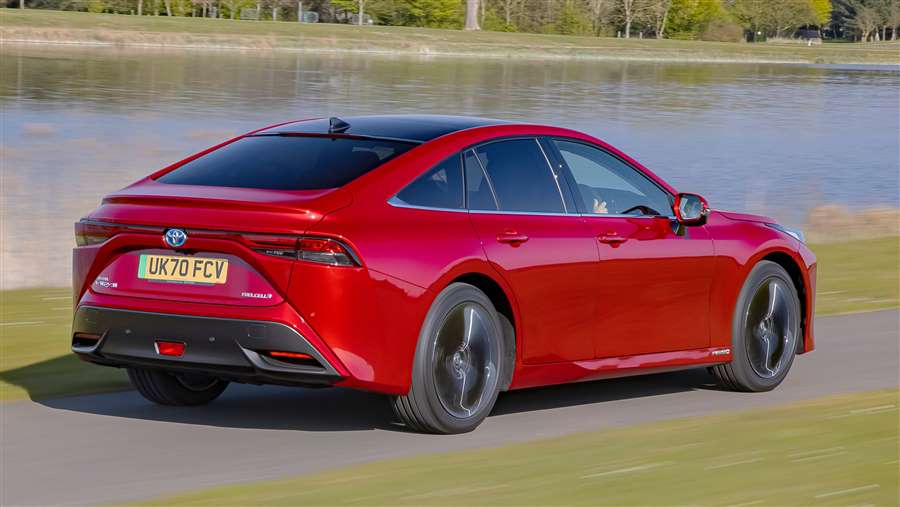
Progress in the Mirai is serene. A nine-second 0-62mph time is a world away from the mind-bending speed of some EVs, but the acceleration feels smooth and linear. Put your foot to the floor, and there is a slight delay before the Mirai jumps ahead, a process accompanied by a sci-fi hum that’s distinct from any other pure-electric car.
The Mirai is set up for a relaxing drive, but that’s not to say it feels stodgy. The ride is forgiving - even on top spec Design Premium Pack trim’s 20-inch wheels - yet the car is neatly balanced front to rear, so it feels stable and predictable. At speed, the only obvious noise is the subdued tyre roar.
So what are the benefits of hydrogen as a fuel source? Well mile-for-mile, it’s significantly lighter than a battery. Whereas a Tesla Model S promises 390 miles from a battery weighing roughly 500kg, the hydrogen that fills the Mirai’s tank weighs just 5.6kg and will carry you for an official range of 400 miles. It means that, overall, the Mirai tips the scales at 1,900kg - on par with a combustion vehicle of a similar size.
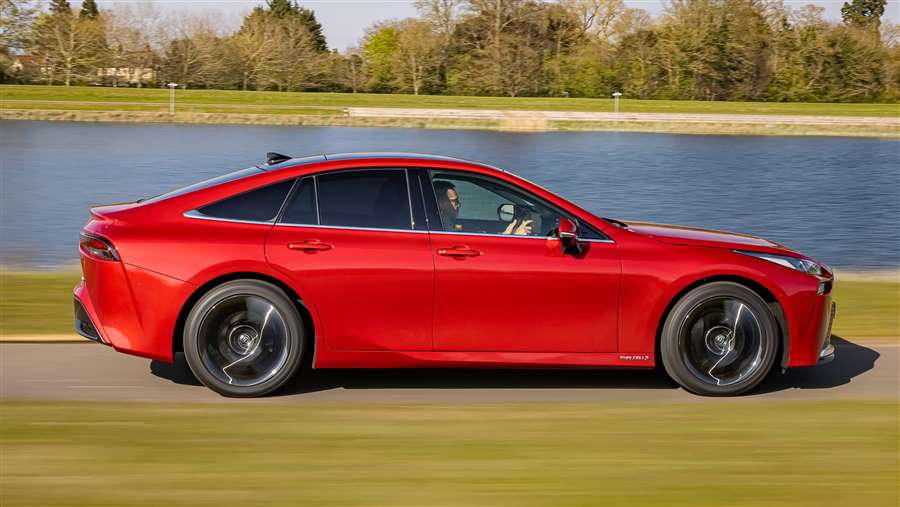
Toyota says that the Mirai consumes 0.89kg of hydrogen every 62 miles; in the UK, a refill costs about £10 per kg. Our test drive covered more enthusiastic driving than most will subject it to, and the Mirai consumed 1.17kg per 62 miles - equating to about £56 for a 300-mile real world range. That’s a similar cost to a petrol car achieving 32mpg.
Of course, filling a hydrogen car represents a stumbling block for the technology. While EV charge points continue to pop up at a relentless pace, the total number of hydrogen filling stations in the UK stands at 14. There are a couple of big stations under construction, but the fuel is definitely more scarce.
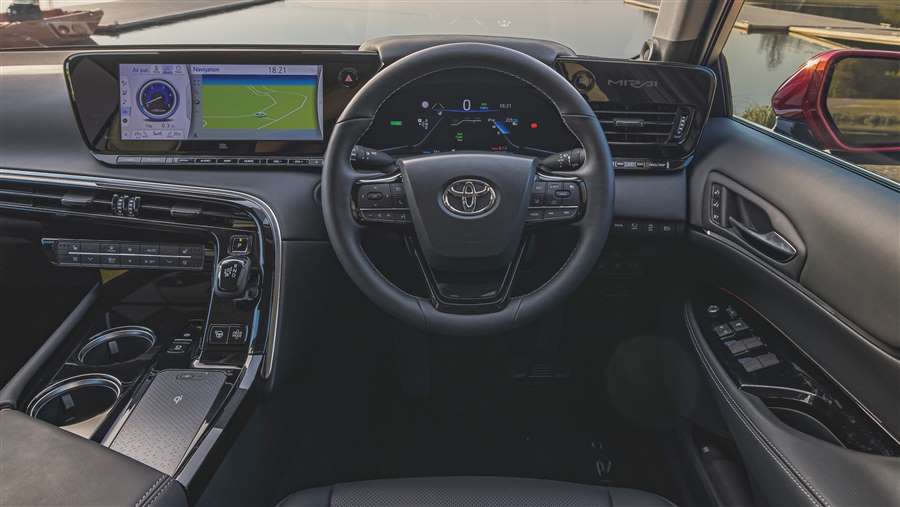
To create hydrogen, it needs to be separated from water via electrolysis, compressed and liquified and, if this process isn’t done on-site, transported to a refuelling station, where the fuel cell then uses more energy to generate its electrical charge, so it’s not the most energy-efficient process.
A full EV effectively skips the admin, taking electricity from the national grid. Of course, there are other factors, such as the sourcing of raw materials, but fuel cell vehicles still need lithium, too.
And while 5.6kg of hydrogen goes a long way, packaging the tanks needed is tricky. The Mirai has three. The largest is mounted within the spine of the car in the floor, which creates a high central tunnel inside. Further tanks are located fore and aft of that, squeezing the cabin from either end. As a result, rear legroom is barely any better than most superminis, and the boot offers just 321 litres - this in a car with a similar footprint to an Audi A7.
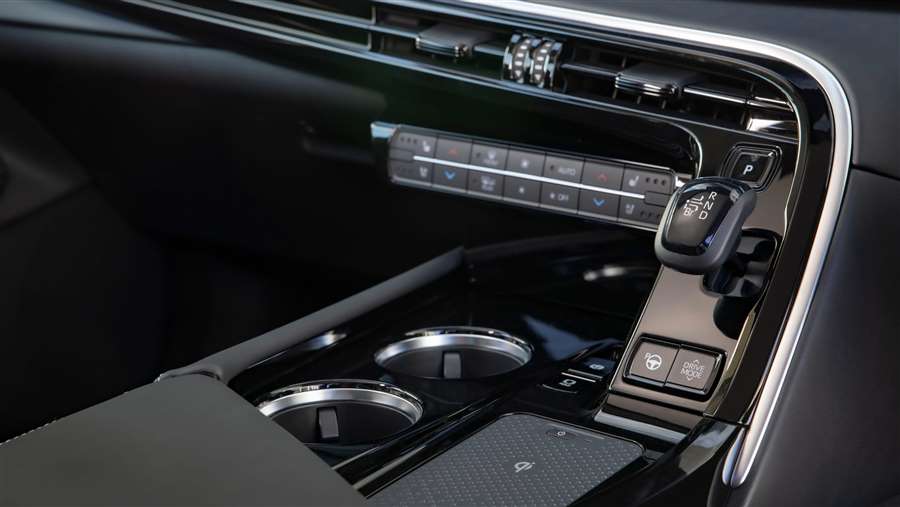
Otherwise, the cabin is well-finished and packed with tech. There’s a huge infotainment screen, a digital instrument panel and a 10.1-inch head-up display. All four seats are heated and cooled, while back-seat occupants get a fold-down centre armrest that houses controls for entertainment and climate functions.
Despite being more powerful, more luxurious and better equipped than before, prices now start from £49,995 - the best part of ten grand less than the first Mirai. This top spec Design Premium Pack costs £64,995. That’s still strong money for the performance, but there’s always a price to pay for being an early adopter.
By Toyota’s own admission, the Mirai is essentially a rolling research lab. It proves the tech works, though its finest application is unlikely to be in cars, but in commercial vehicles. Refuelling stations can be built at transport depots topping up lorries and buses at a speed and with a range that - currently - lithium-ion batteries just can’t compete with. The weight saving of hydrogen relative to a big battery is already significant in a car - it would be enormous once expanded to the size of an HGV.
The Lamborghini Squadra Corse announces a new model (VIDEO)
Last year, Lamborghini’s Squadra Corsa racing department introduced the SC20, a custom-designed speedster with a 6.5-liter V12 that can be found under the hood of the Avendator SVJ Roadster. The racing supercar is capable of producing 770 hp (566 kW) and 719 Nm of torque, and now Lamborghini’s racing division is working on its next creation.
Although the details of the new mysterious Squadre Corsa project are still a secret, a short video announcement suggests that it is a track-only version of the Huracan Evo. As Jutarnji.hr reports, Lamborghini promises that its "latest motorsport car will offer an unprecedented experience".
The rear end is dominated by a huge spoiler and diffuser, and an opening is visible on the roof that optimizes the air flow. The front and rear lights have been redesigned, and the video allows us to hear the sound of a natural V10 engine as well.
Given that the Squadra Corse has already worked on the road-homologated Huracan WTO, we don’t expect this version to be legal for the trip. Instead, this is most likely Lamborghini’s new race car, but it remains unclear in which class it will compete.
Currently, the Squadra Corse competes with the Huracan in international races in the GT3 class and the Super Trofeo series. In addition, it should be noted that Lamborghini recently celebrated the production of the 400th Huracan GT3, so this mysterious project could represent a turning point.
If the new Huracan racer is not limited by motorsport regulations, it should produce significantly more horsepower than the road version of the Huracan Evo, which delivers 640 hp (471 kW) and 600 Nm of torque on the road.
We won’t have to wait long for all the information about the Squadre Corsa project, given that Lamborghini has promised that the new supercar will “race” on the tracks soon.
{vembed Y=KGf3vTZRWyU}
Hyundai Ioniq 5 prototype (2021) review: an electric showstopper
It's clear that Hyundai's mantra must be 'speak softly and carry a big stick.' It just must be. Being among quiet pioneers of family-friendly electric cars already with the original Ioniq and Kona, the brand is about to smack us across the chops with a whole new range of EVs under the Ioniq sub-brand, starting with this: the Ioniq 5.
We've driven a near-finished prototype of for our first whack. Has Hyundai beaten VW at its new game?
What a looker!
Hyundai says the look has been inspired by the Pony Coupe of the 70s but, unlike so many car brands looking to its past to guide its future, design-wise, this is no slavish pastiche. It's an eye-popping piece of design, shaped as a family hatch, with pixelated lighting front and rear and super-crisp lines.
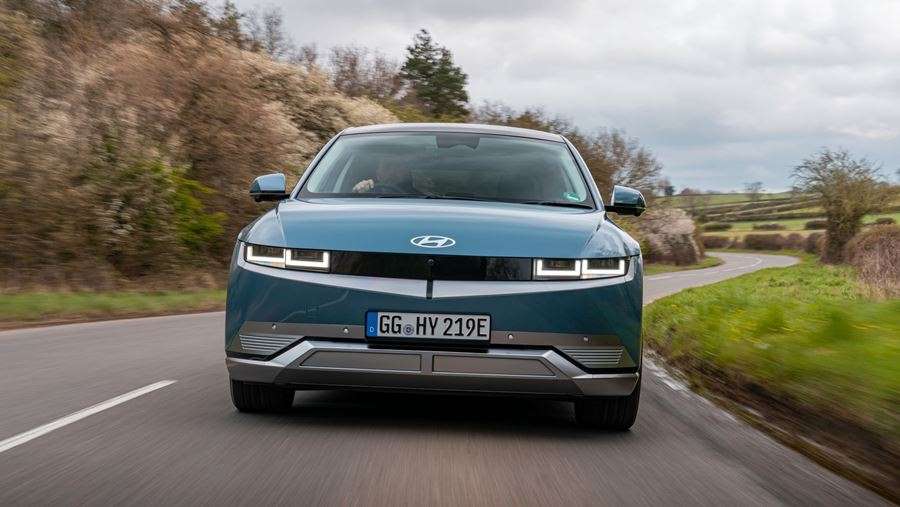
Interestingly, though, the Ioniq 5's dimensions are much larger than you think. This design masterstroke actually hides the car's size: it's actually longer than a VW ID.4 both physically and in terms of its wheelbase and about 40mm taller than a Jaguar i-Pace.
Speaking of the i-Pace and ID range, we conveniently managed to park next to Jag's EV and an ID.3 – both look instantly dated compared to this.
Inside, the cockpit takes full advantage of the e-GMP platform that lies underneath. A flat floor means no fixed centre tunnel, with a movable centre console that provides cupholders, cubbies and a wireless phone charger. You're also greeted by thick padded seats, two massive screens and a kitsch two-spoke wheel like a Honda E.
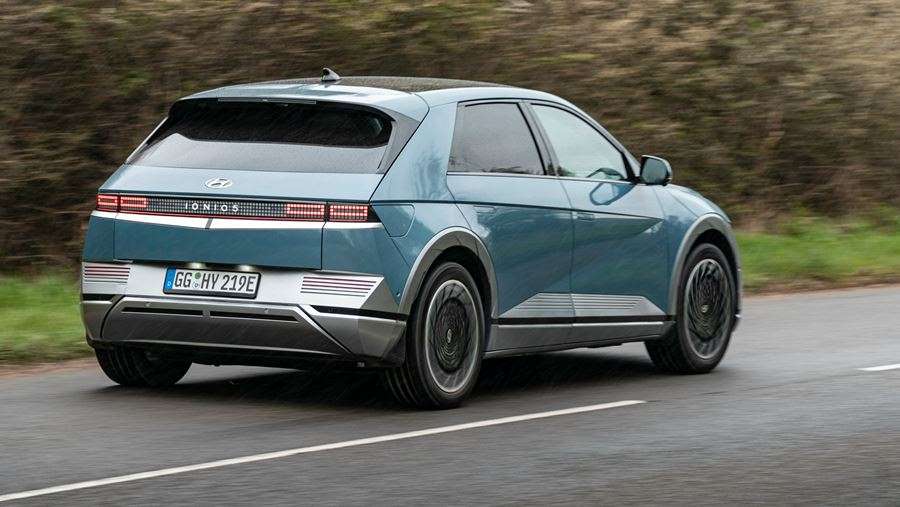
But Hyundai hasn't gone tech overload in here like Mercedes, or ultra-minimalist like a Tesla Model 3 – there's a balance between large, useful screens, touch panels and physical switchgear and solid materials on all your regular touch points. The shift stalk, for example, is on the steering column, with a chunky twist action and the door inlays – complete with eco-friendly paper inserts – all feel solid with a tactile thunk when you pull the door handles.
Space is impressive, too. The cabin itself feels huge once you're inside, with loads of room for rear passengers, too. The rear bench can slide forward and back and, even with a 6ft 2in driver like myself at the wheel, there's tonnes of legroom. The boot, however, is rather shallow, but has depth end to end, and properly usable width. You don't even need to store your cables here – there's a handy storage box under the bonnet for that.
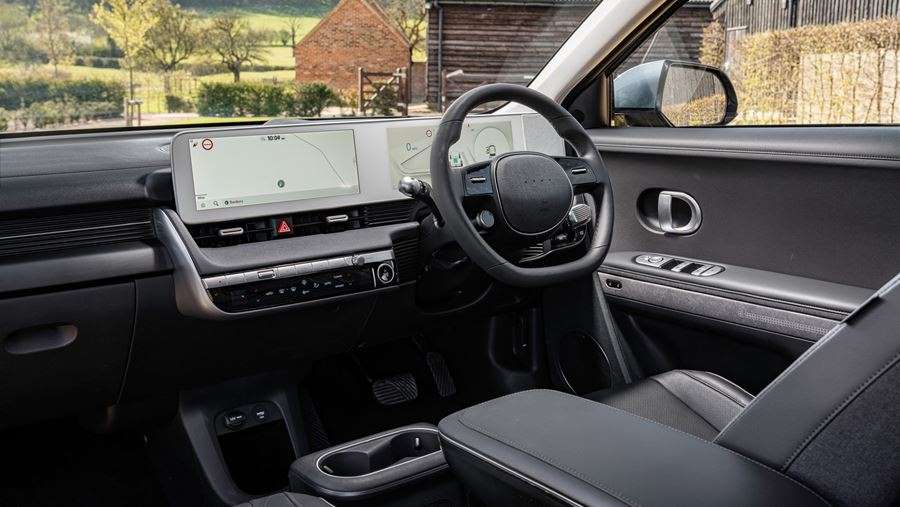
Any clever technology on the Ioniq 5?
The platform, for a start. The new e-GMP platform will underpin every new Ioniq sub-brand model from Hyundai along with Kia's new EV range starting with the EV6. Rear- and all-wheel drive powertrains are offered, with the Ioniq 5 giving you a choice of a standard range 58kWh or long-range 72.6kWh battery packs. And, along with a three-pin plug socket in the car, there's 'vehicle to load' – the ability to use the car as a rolling power bank, allowing you to plug in (via an adaptor on the charging port plug) almost anything externally, like a lawn mower, e-scooter or even another EV.
Hyundai's electric car plans explained
It's also as clever as a Taycan, allowing for both 400 or 800-volt charging, meaning (on the fastest available 350kW chargers, of course) the ability to zap from 10 to 80 per cent charge in just 18 minutes. Hyundai claims 296 miles in the Ioniq's thriftiest setting (larger battery, rear-wheel drive), but you can expect an ID.3 rivalling 260-plus from the all-wheel drive variant.
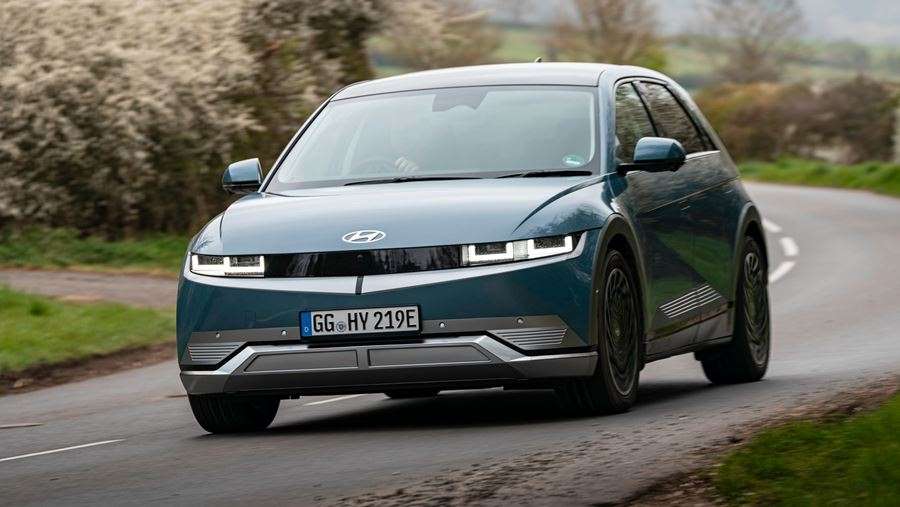
Live in a sunny area? Of course you don't, not in the UK at least, but you can spec a solar cell roof (after the Ioniq's initial launch) that aids the batteries: 'The solar roof has a charging capacity of 205W, and in an environment that is sunny we did some experiments and found that it could add 1200 miles of range per year, or about three miles per day,' Ioniq 5 project manager, Askin Kahraman, told us, 'The roof will also help the 12V battery so the car doesn't discharge completely.'
Then there's all the available tech on board. Along with Level 2.5 semi-autonomous driving tech, you can have Hyundai's Blind Spot View Monitor (that shows you the view of the door mirror camera when you flick the indicator), an augmented-reality head-up display and front seats that recline with leg supports like a living room La-Z-Boy.
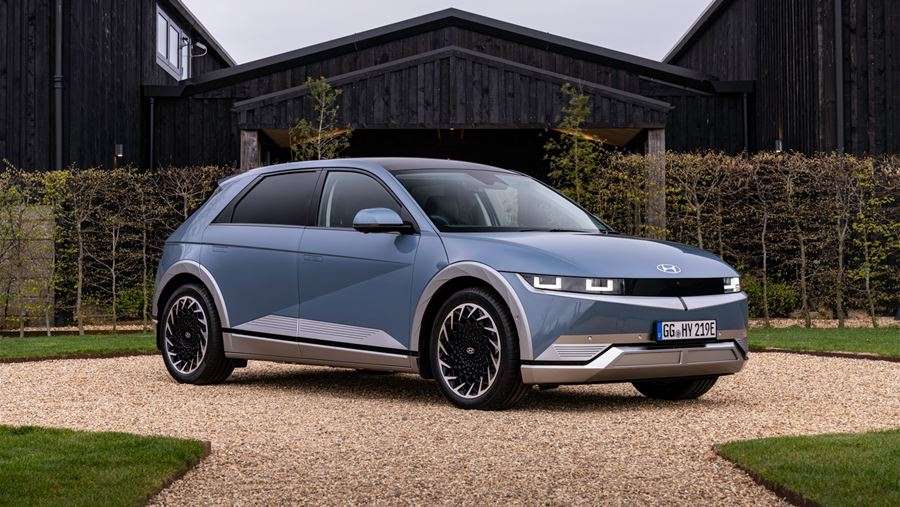
Hyundai's Blind Spot View Monitor: does it work?
Our car was fully trimmed with every frippery you could ask for, implying that it was one of the limited-run 'Project 45' versions, at £48k. On top of all the tech that gives you, it also means your Ioniq 5 comes with the bigger 72.6kWh battery and all-wheel drive. As for lower trims, we expect it to follow the same trim structure as Hyundai's other models: SE Connect, Premium and Ultimate, with the cheapest models circling the £39,000 mark.
Let's drive it!
Walk on up to it and flush doorhandles pop out, ready for the drive ahead. Given the front seat's reclining nature, the whole seat angles backward if you want thigh support – rather than just the front end of the base – and the wheel adjusts for plentiful reach and rake.
Once you're rolling, the 5's interesting details don't instantly reveal themselves – it feels entirely standard fare for a family EV – quiet, inoffensive and smooth when you're nipping around town. And properly quick, just like an EV with so much torque should be; Eco mode dulls the throttle while, at the other end of the drive mode scale, the dials glare red in Sport and the throttle response is incredible. And this simply won't be the most powerful version of the E-GMP platform, either. Kia, for example, has already shown off a supercar-baiting EV6 GT, so it's not beyond the realms of possibility that Hyundai could make an Ioniq N.
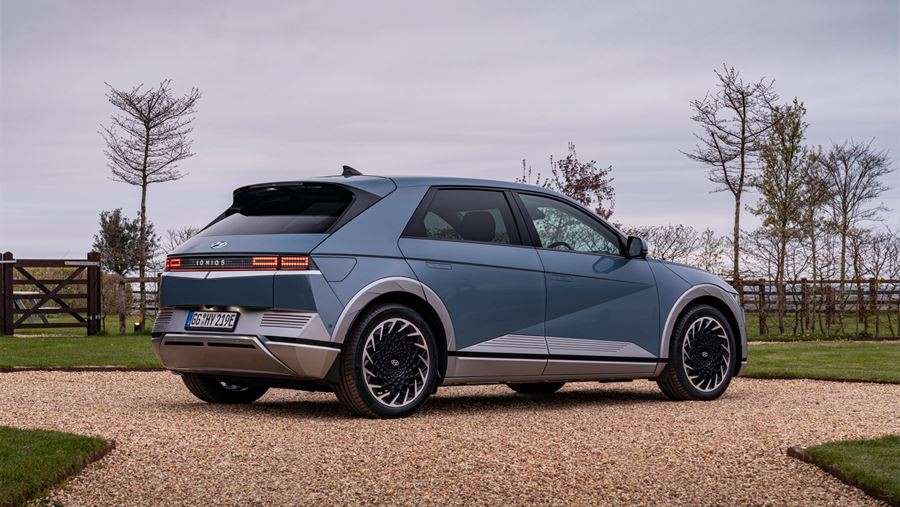
Then you start to notice the finer points after the miles roll on.
The steering, for example, is live-wire alert and well-weighted – no dead-spots off-centre and tremendously fluid when you wind the lock off after a turn. The turning circle is tight, too; not London Taxi or Honda E tight, but not far off. Then there's the brakes. It's almost an expectation for an electric car to have a soggy brake pedal and inconsistent feel when you apply some pressure due to regenerative braking (of which Hyundai has four steps, plus a one-pedal mode), but not here. Plenty of solid, accurate feel regardless of regeneration level.
You can really have fun with this car on a back road – something not often said this side of a Taycan. Adding up the whumping torque, sharp steering and feelsome brakes is already plenty good enough, but there's real balance to the chassis, too. This doesn't feel leaden or recalcitrant when you want some zippy thrills going the fun way home. Yes, there's a touch of body roll, but the way the suspension handles the Ioniq's weight is really something to be commended – it's a hoot.
We even got some time on the motorway. Hyundai told us that not all of the production-spec soundproofing is on this prototype but, if that's the case, I've driven plenty of family in-production family cars (including those of premium manufacturers like Audi) that riding on 20-inch wheels that have worse NVH refinement. Tyre noise is well within an acceptable level and wind noise is minor. Couple this with balanced ride quality – not too jittery, but not water bed wallowy either – and it's a very promising position to be in.
First impressions: Hyundai Ioniq 5
What an impressive machine. We can't wait to try a production-spec one but, even in this prototype, the Ioniq 5 brings such a breadth of abilities that other EVs can only dream of. Show-stopping looks, a thoroughly usable and appealing interior, and sharp dynamics that are rare to find in a heavy family EV.
Convinced by VW's ID.3? Try one of these first.
(carmagazine.co.uk)
New era: Renault will no longer develop diesel engines
Apart from the fact that the French manufacturer will no longer invest in the development of new diesels, it also announced that it limits the maximum speed to 180 km / h for new models.
At the recent Renault Group shareholders' meeting in Paris, CEO Luca de Meo also announced the maximum speed limit for all future models coming from this company.
"Speed on all our cars will be limited to 180 km / h," said de Meo, who has led Renault since last year.
He also announced that the first model equipped with a new electronic device that limits the maximum speed will be a serial version of the Renault Mégane eVision concept, ie the Renault Mégane E model announced for the next year, 2022. Moreover, the blockade on it will be even more extreme, ie it will be set at 160 km / h.
In addition to the device that will block the maximum speed (and will not be able to unlock), the electric SUV will be the first Renault equipped with another limiting system - automatic speed control called Safety Coach - active speed limiter, which will comply with speed limits and geolocation data, will take into account the road profile, examples of dangerous curves, weather conditions…
De Meo claims that he was led to these moves by statistics according to which speed is still responsible for a third of all traffic accidents with a fatal outcome, so he hopes that the restriction will significantly help increase road safety.
Furthermore, what Renault has developed from diesel engines - it has developed, because it will no longer invest in them, but will improve the current ones to the level as much as possible in terms of environmental standards.
CEO De Meo also confirmed that he will no longer invest money in the development of new generation diesel engines, and whether that means that Renault diesels will not exist in the Euro 7 era remains to be seen. However, seeing how the demand for hybrid and electric cars in Europe exceeds diesel, it will not be a surprise if French models with diesel engines disappear from the market in 2025.
Admittedly, diesel has already been discontinued in many models, and even Dacia has begun rejecting diesels in its latest generation of models in Europe.
Mercedes-Benz S-Class review
Big Mercedes-Benz comes loaded with tech, but feels less weighed-down
Is the Mercedes-Benz S-Class any good?
You bet! Without fail, each new generation of Mercedes-Benz S-Class is tasked with setting new standards of excellence. And in the case of this one, its maker has pulled out all the stops with a car that's designed to be smoother and more serene than ever before.
But even if you're not in the market for a high-priced luxury car, you reall should take notice of this one. Much of the technology that debuts in this car will undoubtedly filter down into more popular cars over the next few years.
The S-Class also needs to be exceptional, as it faces a diverse and incredibly capable set of rivals in the form of the Audi A8, BMW 7 Series, Bentley Flying Spur and the Rolls-Royce Ghost. It also has to battle top-end SUVs, such as the Mercedes-Benz GLS as well as the ever-popular Range Rover.
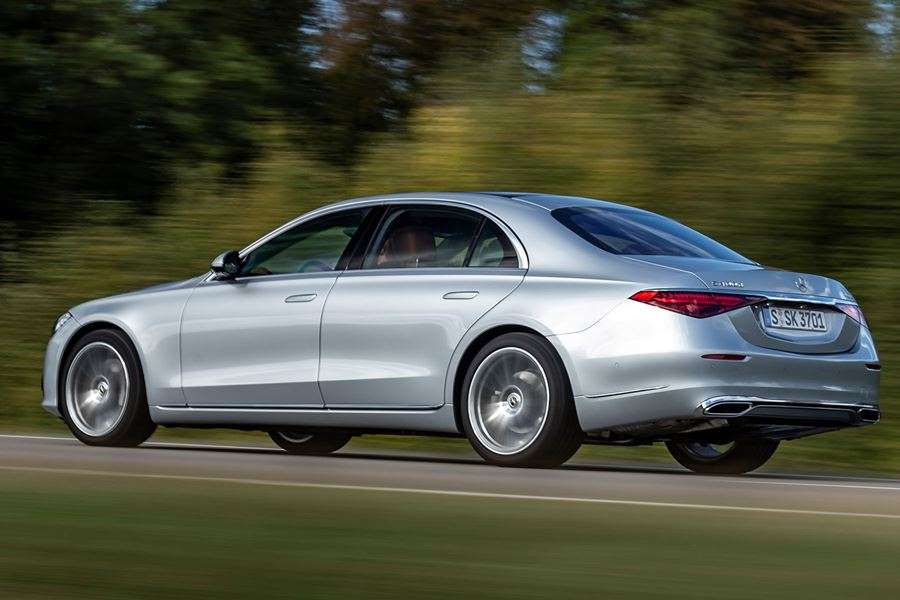
This is ignoring the growing selection of four-door coupes as well (Mercedes’ own offering, the CLS, is based on the E-Class but traditionally delivers the luxury of an S-Class in a sportier, smaller package) and Porsche Panamera. There are many, many vehicles the S-Class needs to outclass to get your attention – and, apologies for the spoiler, but we think it manages it.
What's it like inside?
This is, perhaps, the most welcoming S-Class interior yet, with an almost cosy wrap-around feel and lavish, soft surfaces everywhere. Technology still defines the S-Class' mission to blaze a trail others follow though, and there's a single, large display panel that slopes downward, with a central infotainment touchscreen dominating the overall view up front.
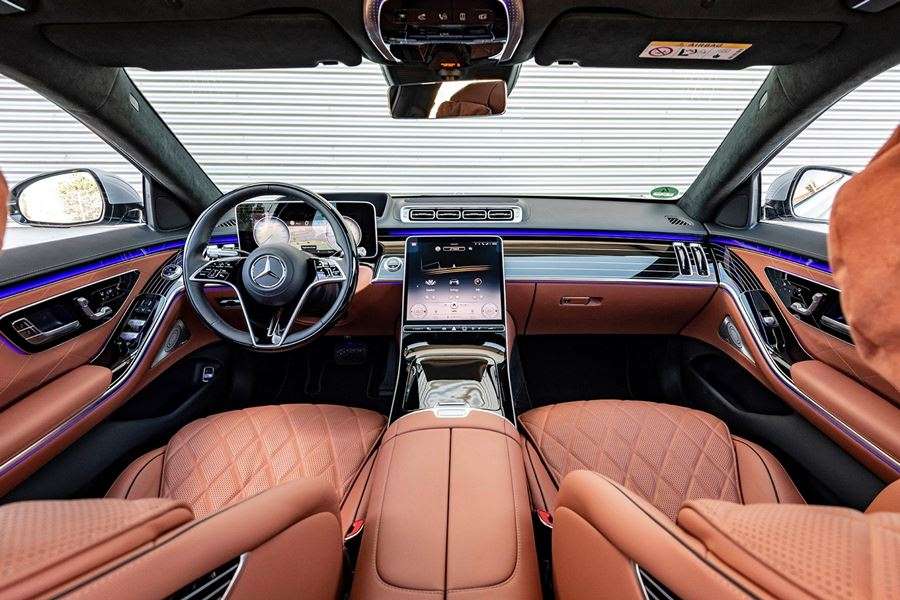
A new air filtration system is included, which can do things like pump perfume into the vents and automatically activate the recirculation setting when you go through a tunnel.
The 12.8-inch control screen is available with haptic feedback and OLED technology, and is easy to read from all angles and interact with as a conseqence. That clean interior design approach extends to the use of an augmented reality head-up display and 3D instruments that can be reduced to a minimal amount of information.
Several different designs can be had for the digital instruments, including a sporty one with red dials, to the classy Exclusive theme that displays white dials and backgrounds.
Mercedes-Benz’s MBUX 'Hey Mercedes' voice assistant has also had an upgrade, allowing for even more natural speech. If someone says they’re tired, one of the car's Energising Comfort programs can be activated, for example. When certain prompts arise, like an incoming call, the ‘Hey Mercedes’ activation phrase is not required – someone can simply say ‘Accept call’ – all in an attempt to simplify using the car's vast array of functions.
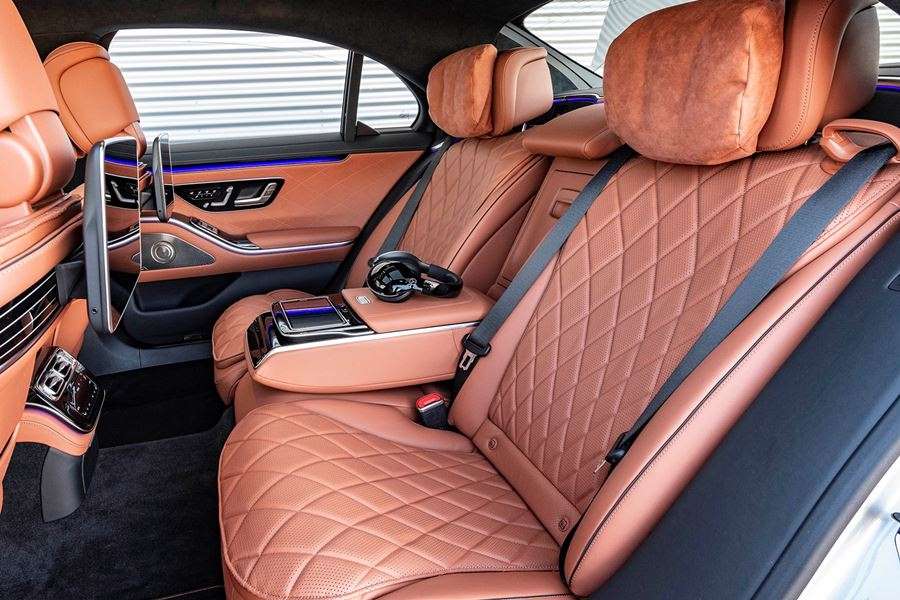
What's it like to drive?
Currently, there are two diesels and one petrol to choose from, all of which use Mercedes-Benz’s latest straight-six engine range. The S 500 petrol also has 48v mild hybrid assistance that helps boost torque and all hit 155mph. We've only driven the S 500 version so far, but it's powerful, smooth and surprisingly economical, given its size.
Unsurprisinly, S-Class majors on comfort – it rides on air suspension that lowers itself automatically at speed while giving a soft ride for passengers. Rear-wheel steering is also available in two versions, with one set-up allowing the rears to turn at up to 10 degrees. Mercedes claims that, four-wheel steering gives an S-Class has a similar turning circle to an A-Class hatch.
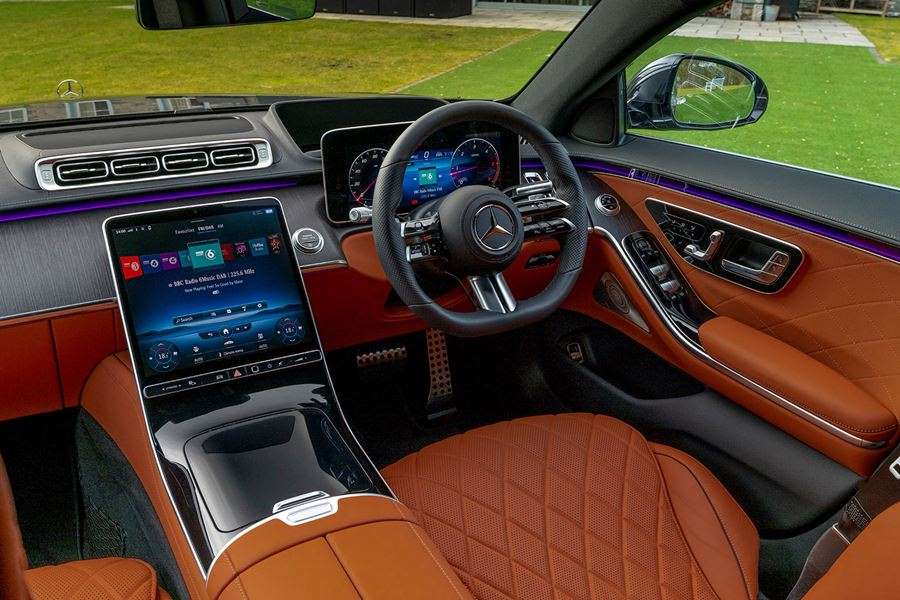
One advanced option is the E-Active Body Control system, which allows the new S-Class to tilt into corners like a Pendolino train. The technology also raises the ride height by 8cm when sensors detect a side impact is imminent, positioning the chassis to take the brunt of the crash via the door sills, rather than the doors themselves.
What models and trims are available?
The diesel line-up comprises of an S 350 d (286hp) and the 330hp S 400 d 4Matic (meaning four-wheel drive), while the petrol is the S 500 4Matic, which boasts a power output of 435hp. More models will follow in the coming months.
There are six trim levels to choose from – AMG Line, AMG Line Premium, Long AMG Line Premium, Long AMG Line Premium Executive, Long AMG Line Premium Plus and Long AMG Line Premium Plus Executive.
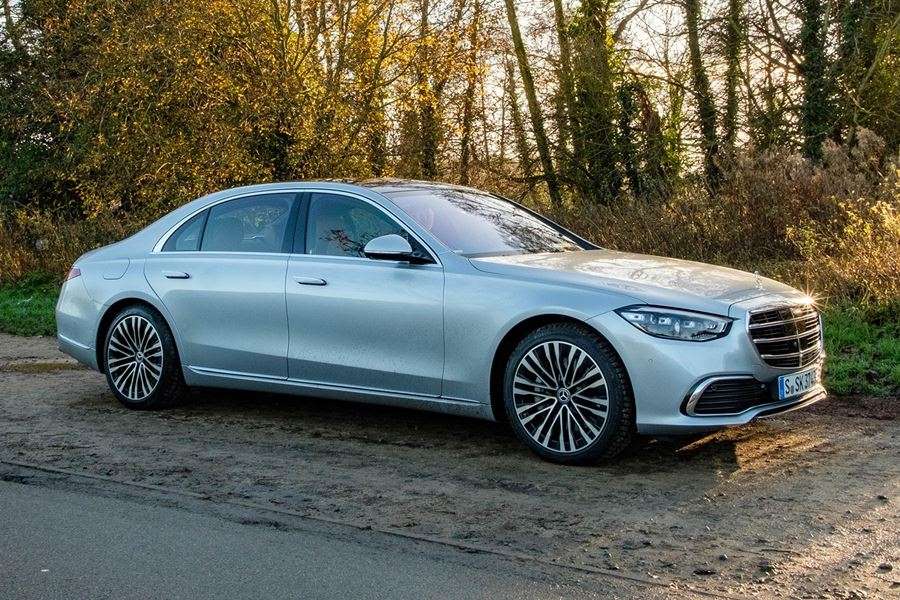
Even the entry-level AMG Line model is well equipped, coming with 19-inch wheels, air suspension with self levelling, keyless-go with seamless door handles, Intelligent LED headlights, parking package with reversing camera and power closing doors and bootlid. Move up the range and start plundering the options list at the sky's your limit.
What else should I know?
You can order an S-Class now, with deliveries set for later in the spring of 2021 – with the diesel S 400 d version offering the fuel consumption, and the S 500 giving the quickest performance, as you'd expect. But on paper, the gap between petrol and diesel has closed considerably. The gamechanger will be the plug-in hybrid S 580e, which is due to go on sale late in 2021.
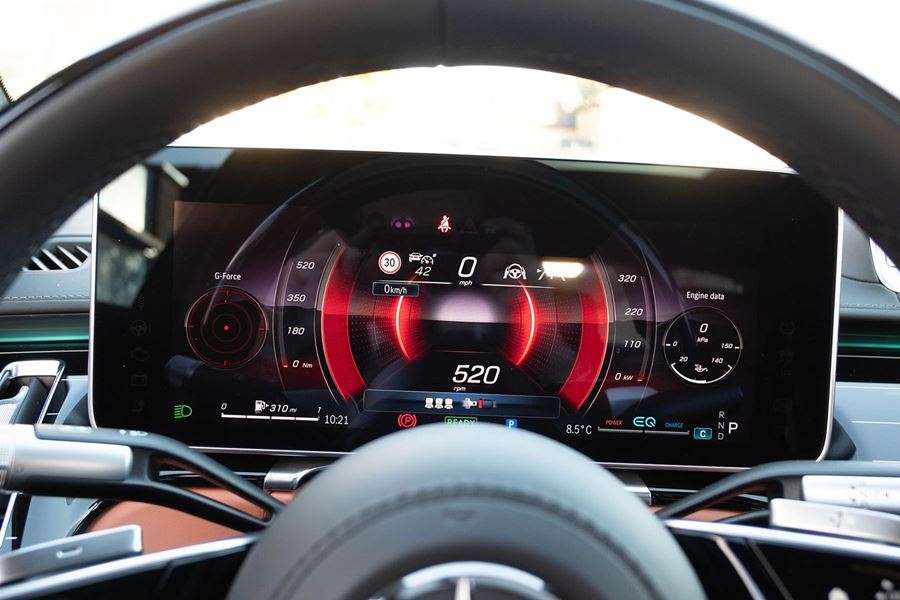
Don't expect your local Mercedes-Benz dealer to be offering discounts any time soon, as it's so new and interest is running high. The number of cars coming to the UK will be limited so as to keep a firm control on supplies. We'll know more about reliability and ease of running as the year unfolds, but we don't expect it to be much different to the last S-Class, which was held in high regard in that respect.
(parkers.co.uk)
Prince Philip's car "star" of the museum - "Standard nine" from 1935.
The nearly 90-year-old car, which once belonged to the recently deceased British Prince Philip, is on display in a museum in Sri Lanka, where it is considered a central exhibit.
The Duke of Edinburgh, who will be buried tomorrow, was a big fan of cars, and he bought the "standard nine" from 1935 for 12 pounds during his stay in the largest city of Sri Lanka, Colombo in 1940, as a member of the British Royal Navy.
"When he returned in the early fifties, he came and looked at the car. He said that he hoped that the brakes were correct because they were not there before, "said Sanjiv Gardiner, who kept the car in his hotel" Gal Face "in Colombo.
Gardiner said Prince Philip admitted that the car was the first vehicle he bought. The Duke of Edinburgh became the patron of the Motor Vehicles Club "Standard".
The Gale Face Hotel is one of the oldest in the former British colony, and the museum is built around a silver-and-black passenger vehicle.
Prince Philip failed to lower the price of the used vehicle, although he managed to pay in two installments within a month.
According to the documents kept in the museum, Prince Philip drove the mentioned car for the first time from Colombo to the naval base in Trikonmalia, which is located 260 kilometers from the largest city of Sri Lanka.
"The car has covered 93,040 kilometers, has been restored several times and can still be driven, but the insurance costs are high, which means that it is no longer used," Gardiner told AFP.
Gardiner's father Cyril bought this car in the early 1950s. He rented a "Cadillac" to the royal family, in which Prince Philip and Queen Elizabeth II rode during the first official visit to Sri Lanka in 1954.
According to Gardiner, the restoration of two cars used by members of the royal family is underway.
Prince Philip, who passed away last week at the age of 100, was a great lover of cars and often drove them himself.
However, in 2019, he handed over his driver's license after a collision that caused his car to overturn and in which two more people were injured.
The coffin in which the Duke of Edinburgh will be buried will be driven to the Windsor Castle tomorrow by a "Land Rover Defender", a vehicle designed by Prince Philip.

